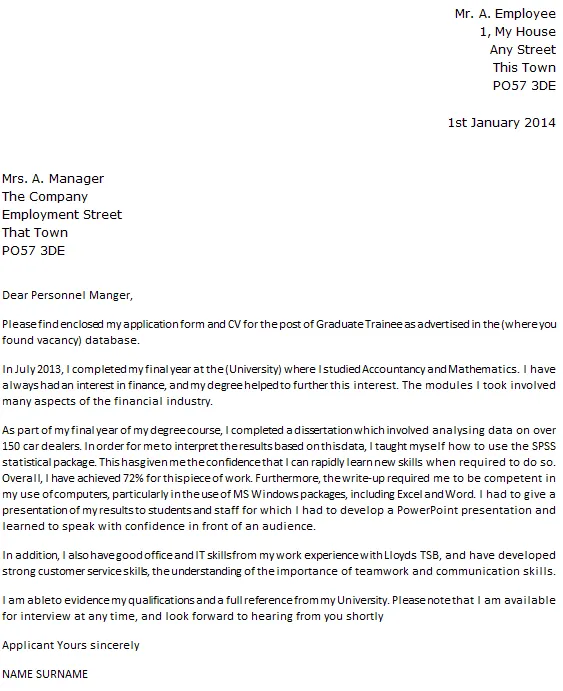Understanding the Finance Cover Letter
A finance cover letter is more than just a formality it’s your first opportunity to make a positive impression on a potential employer. It serves as a concise introduction, providing context to your resume and highlighting your relevant skills, experience, and career aspirations. A well-crafted cover letter can significantly increase your chances of securing an interview by showcasing your personality and passion for the finance industry. It’s your chance to demonstrate that you’ve done your research and are genuinely interested in the specific role and company.
Why a Cover Letter Matters
In a competitive job market, a cover letter provides a crucial advantage. It allows you to personalize your application, explain any gaps in your employment history, and articulate your career goals. Unlike a resume, which presents a factual account of your professional background, a cover letter lets you tell your story. It provides an opportunity to connect your skills to the job requirements and to demonstrate your understanding of the company’s mission and values. A compelling cover letter can differentiate you from other candidates, especially if you are applying for a finance position where attention to detail and clear communication are highly valued.
Key Components of a Finance Cover Letter
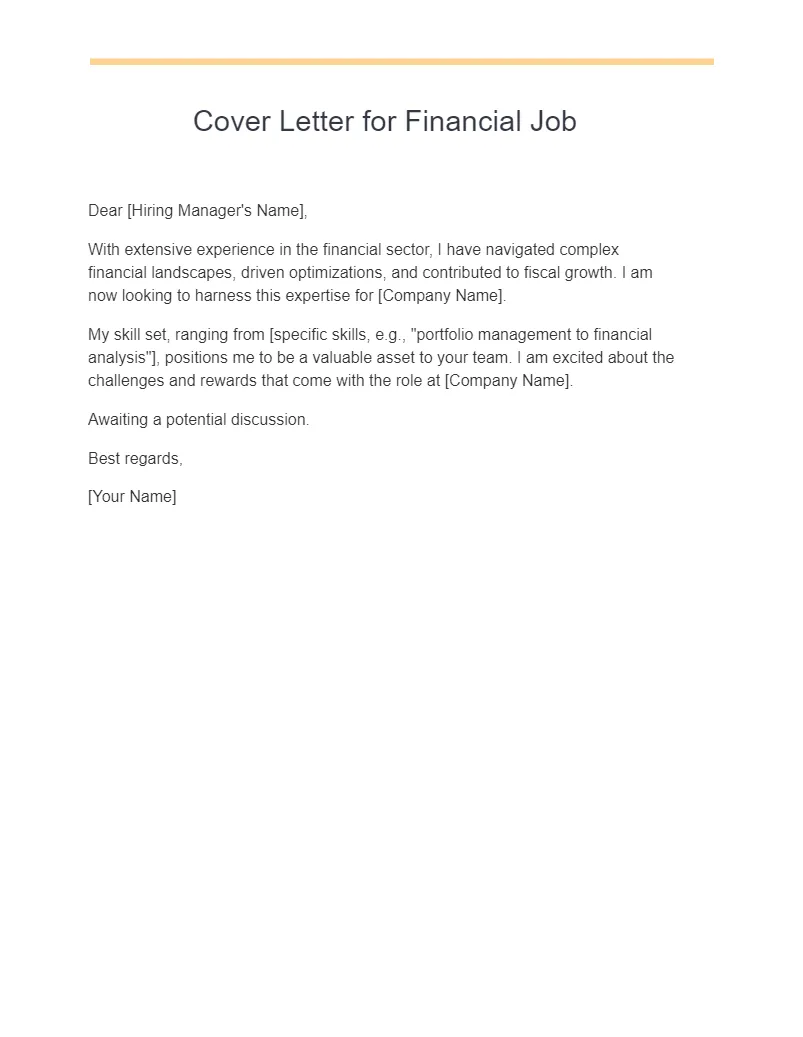
A successful finance cover letter comprises several key components. Each section plays a critical role in conveying your qualifications and enthusiasm. Ensuring that all essential elements are present can help you create an effective and impactful application. These include proper formatting, a clear and professional tone, and a tailored approach to the specific job. Pay close attention to details, as these can make a significant difference in how your application is perceived. Proper structure and presentation are equally important.
Header and Contact Information
Start your cover letter with a professional header that includes your full name, contact information (phone number and email address), and the date. Also, include the hiring manager’s name and title, and the company’s address, if available. This information should be clearly displayed and easy to find. This is a standard practice in formal correspondence and helps the employer contact you easily. Consistency in formatting across your resume and cover letter reflects professionalism. Be sure to double-check your contact details to avoid any errors.
The Greeting
Address the hiring manager by name whenever possible. Researching the hiring manager’s name shows your attention to detail and genuine interest. If you can’t find a specific name, use a professional salutation, such as “Dear Hiring Manager.” Avoid generic greetings like “To Whom It May Concern,” which can make your application feel impersonal. Using the correct name can immediately establish a connection and set a positive tone. Proper greetings are crucial for setting a respectful and professional tone for your cover letter.
Body Paragraph 1 Highlight Your Skills
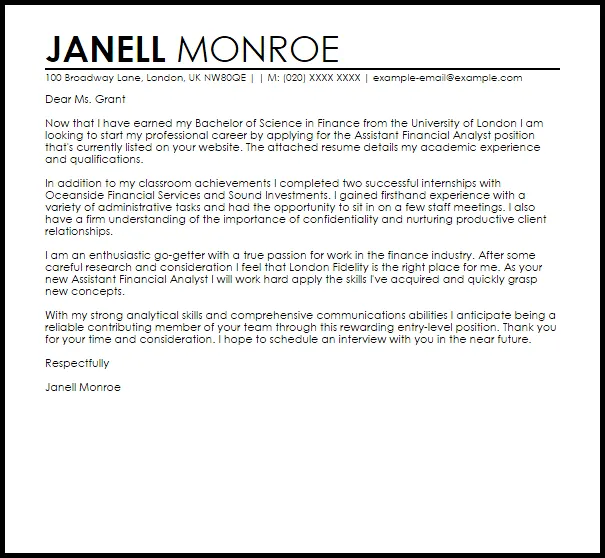
The first body paragraph should grab the reader’s attention and briefly state the position you’re applying for. Then, highlight your most relevant skills and qualifications, directly relating them to the job description. Be specific and provide examples of how you’ve used these skills in past roles. For instance, if the job requires financial modeling, mention your proficiency with specific software or your experience developing financial models. This paragraph should emphasize your understanding of the role’s requirements and your ability to meet them. Make it clear why you are a good fit for this specific position.
Body Paragraph 2 Showcasing Achievements
In the second body paragraph, showcase your achievements using the STAR method (Situation, Task, Action, Result). Quantify your accomplishments whenever possible. For example, instead of saying “Improved efficiency,” say “Improved departmental efficiency by 15% through process optimization.” This section is where you demonstrate the value you brought to previous employers. Use action verbs to describe your contributions, such as “managed,” “analyzed,” “developed,” or “implemented.” This section should be concise and focused on your greatest accomplishments that align with the job requirements. Demonstrate you are a results-oriented candidate.
Body Paragraph 3 Expressing Enthusiasm
Use the third body paragraph to express your enthusiasm for the role and the company. Explain why you’re interested in this particular position and what specifically attracts you to the company. Do your research and mention specific aspects of the company’s mission, values, or recent projects that resonate with you. This paragraph shows that you’ve thoroughly researched the company and are genuinely interested in being a part of their team. Expressing genuine interest can leave a lasting positive impression, making you a memorable candidate.
The Closing
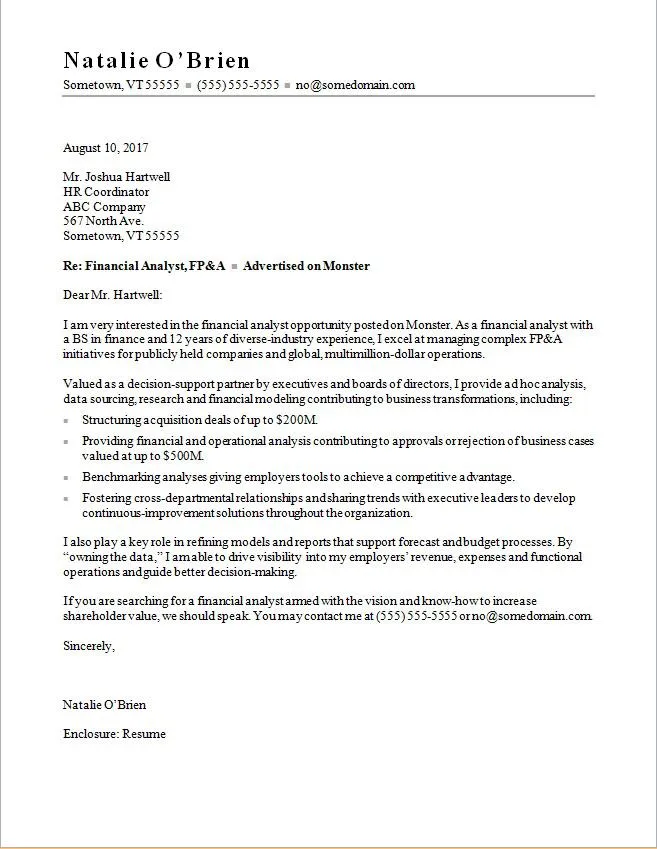
End your cover letter with a strong closing. Reiterate your interest in the position and thank the hiring manager for their time and consideration. Include a call to action, such as “I look forward to the opportunity to discuss my qualifications further in an interview.” Use a professional closing, such as “Sincerely” or “Best regards,” followed by your full name. Avoid generic or informal closings, as these can undermine the professionalism of your cover letter. A well-crafted closing reinforces your enthusiasm and encourages the next step in the hiring process.
Formatting and Design
The formatting of your cover letter is just as important as its content. Use a clear, readable font such as Times New Roman, Arial, or Calibri, with a font size of 11 or 12 points. Maintain consistent formatting throughout the document, including margins (typically 1 inch on all sides), line spacing (single-spaced within paragraphs and double-spaced between paragraphs), and paragraph alignment (left-aligned). Make sure your cover letter is easy to read and visually appealing. A well-formatted cover letter indicates professionalism and attention to detail. Poor formatting can distract the reader and make it difficult to focus on the content.
Proofreading and Editing
Thoroughly proofread and edit your cover letter for any errors in grammar, spelling, and punctuation. Errors can undermine your credibility and make you seem careless. Read your cover letter aloud to catch any awkward phrasing or sentence structure. Ask a friend or career advisor to review your letter for a second opinion. Ensure that your cover letter is free of any typos or grammatical errors. Careful proofreading is an essential step in the job application process, as it reflects your attention to detail, which is highly valued in the finance industry.
Tailoring Your Cover Letter
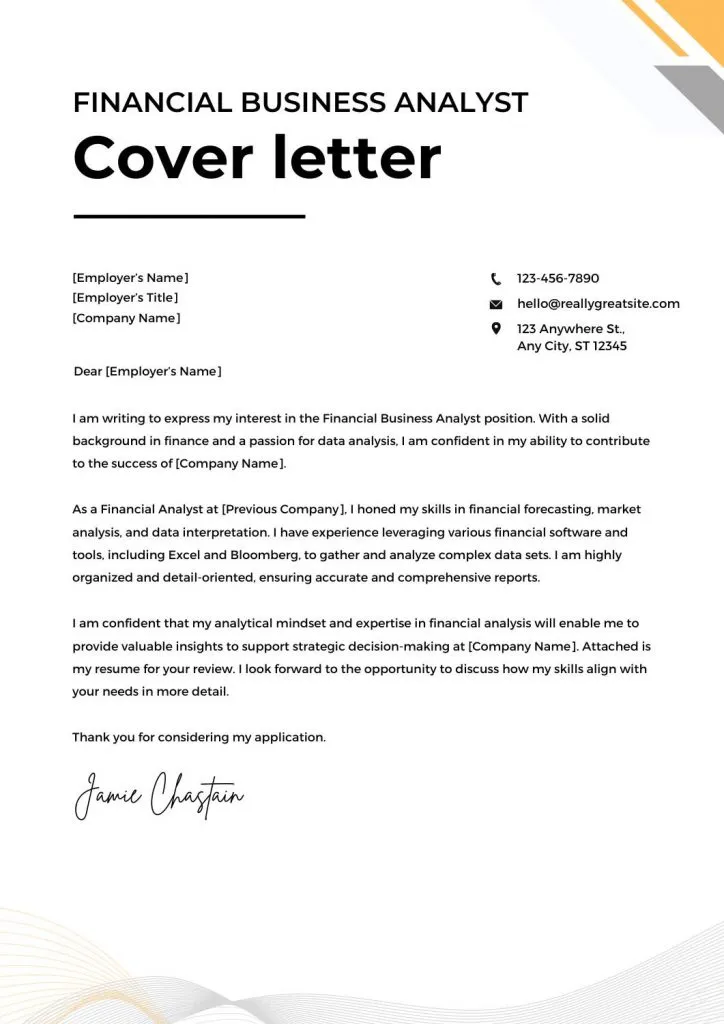
Customize your cover letter for each job application. Do not use a generic cover letter template. Research the company and the specific role to tailor your letter to their needs and expectations. Identify the key skills and qualifications listed in the job description and highlight how your experience aligns with them. Use keywords from the job description throughout your cover letter to show that you understand the requirements. Tailoring your cover letter demonstrates your interest in the specific role and increases your chances of getting noticed. This shows you’ve invested time in understanding the company’s needs.
Researching the Company
Before writing your cover letter, thoroughly research the company. Visit their website, read their mission statement, and review their recent news and projects. Understand the company’s culture and values, and consider how your skills and experience align with them. If possible, research the hiring manager or the team you’d be working with. This level of preparation will enable you to write a more persuasive and personalized cover letter. Demonstrating your knowledge of the company shows initiative and genuine interest.
Using Keywords
Incorporate relevant keywords from the job description into your cover letter. Applicant Tracking Systems (ATS) often scan cover letters and resumes for these keywords to filter out unqualified candidates. Identify the key skills, qualifications, and requirements listed in the job description and include those terms in your cover letter. Ensure that you use these keywords naturally within the context of your writing; avoid keyword stuffing. Strategically using keywords can significantly increase the chances of your cover letter and resume being selected for review.
Examples of Finance Cover Letters
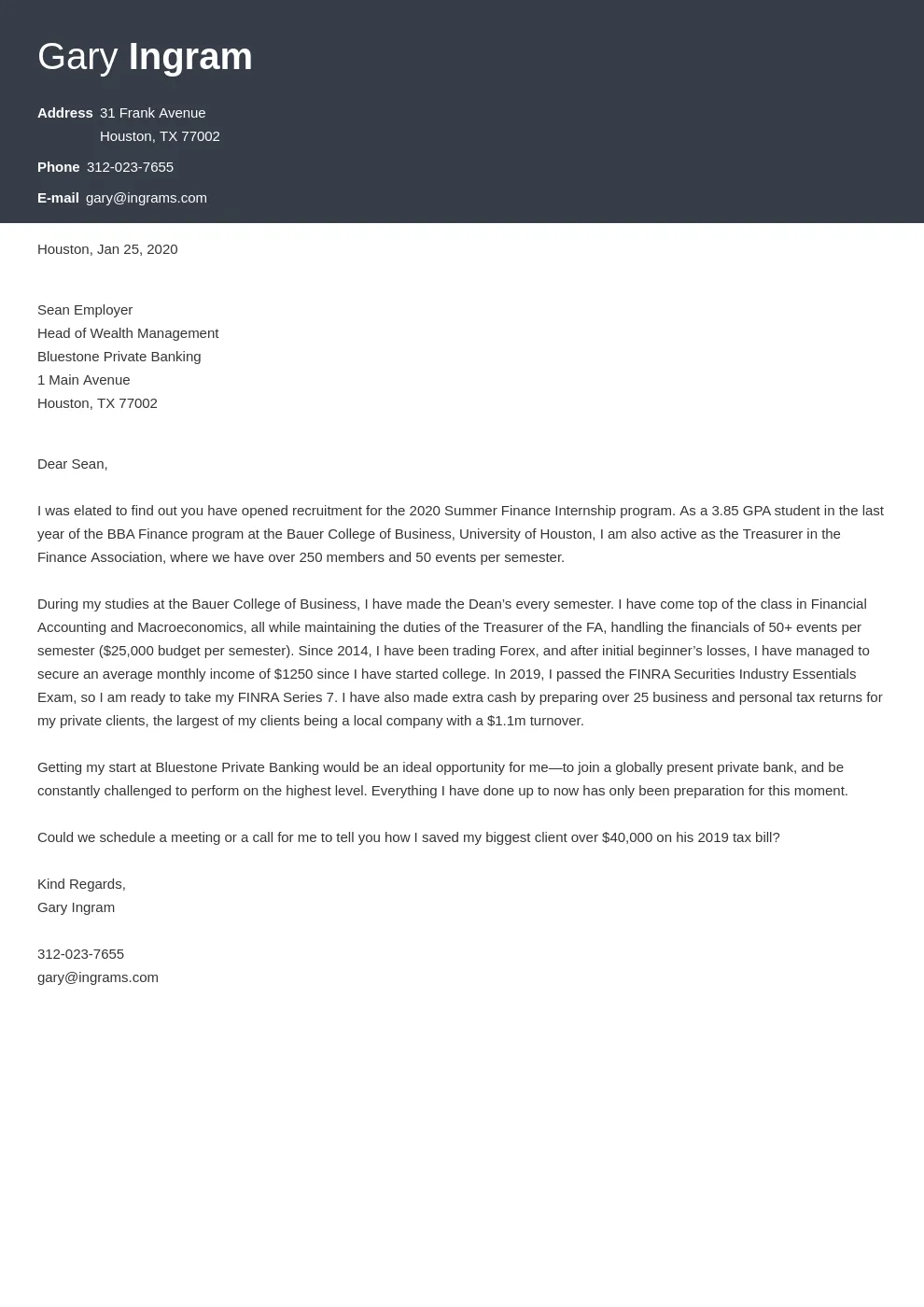
Reviewing examples of finance cover letters can help you understand the structure and tone that employers expect. Many online resources offer sample cover letters tailored to various finance roles, such as financial analyst, accountant, or financial advisor. Pay attention to how the examples highlight skills, achievements, and enthusiasm. Adapt the examples to fit your experience and the specific job you’re applying for. Use these samples as inspiration, not direct copies. Customizing your letter based on these examples can help you create a strong, tailored application.
Entry-Level Finance Cover Letter Example
Entry-level finance cover letters typically focus on academic qualifications, relevant internships, and transferable skills. Highlight any coursework related to finance, such as accounting, finance, or economics. Emphasize any internships or part-time jobs where you gained experience with financial analysis, data entry, or customer service. Showcase your enthusiasm for the finance industry and your eagerness to learn and grow. The letter should demonstrate your potential and eagerness to contribute to the company. Example: “As a recent graduate with a degree in Finance and experience in financial analysis during my internship at XYZ Corp, I am excited to apply for the entry-level financial analyst position. My coursework in financial modeling, coupled with my practical experience, makes me confident in my ability to contribute to your team.”
Experienced Finance Professional Cover Letter Example
Experienced professionals should highlight their significant accomplishments and quantifiable results. Focus on your achievements in previous roles, such as increasing revenue, reducing costs, or improving efficiency. Demonstrate your leadership abilities and your ability to manage teams. The letter should provide a brief but impactful overview of your career and your value proposition. Example: “In my previous role as Senior Financial Analyst at ABC Company, I led a project that improved the accuracy of our financial forecasts by 20% and streamlined the budgeting process, resulting in significant cost savings. I am eager to leverage my expertise in financial modeling, risk management, and team leadership to contribute to your organization.”
Common Mistakes to Avoid
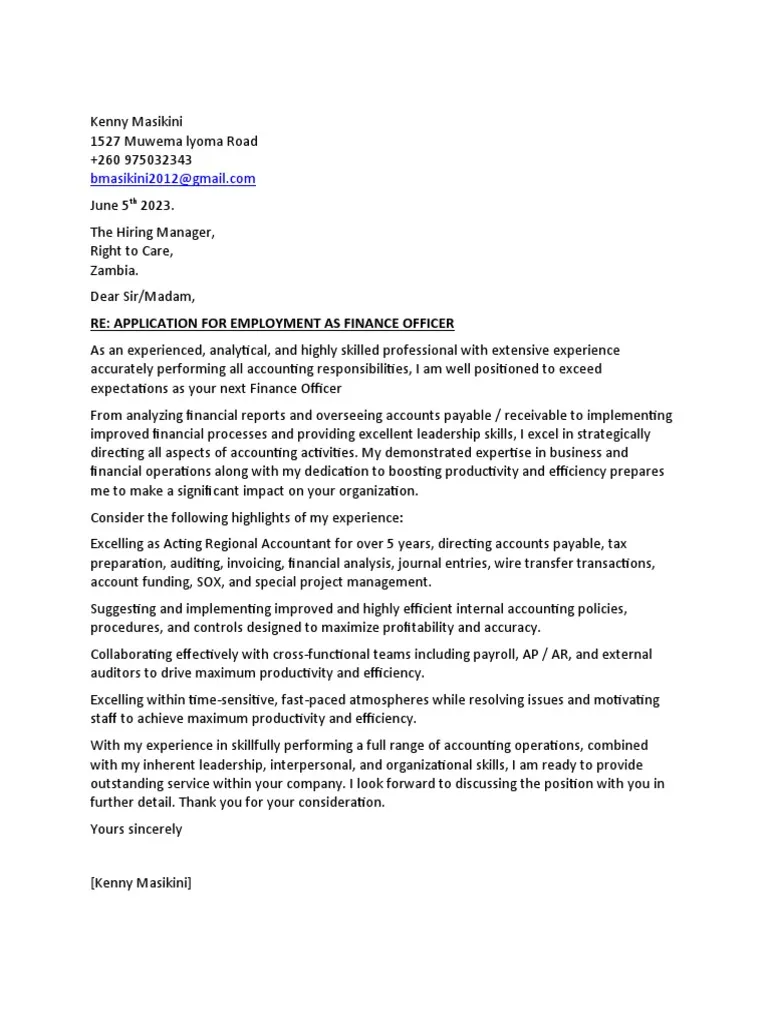
Several common mistakes can undermine your finance cover letter. Avoid these pitfalls to increase your chances of success. Attention to detail is crucial in the finance industry, so it’s important to present yourself as a competent and professional candidate. Ensure you address all areas in the appropriate way.
Generic Language
Avoid using generic language and clichés. Instead, be specific and highlight your unique skills and experiences. Avoid phrases like “I am a hard worker” or “I am a team player.” Instead, provide specific examples that demonstrate these qualities. Use your cover letter to showcase your unique value proposition. A finance cover letter needs to highlight your specific skills and experience rather than use generic language.
Typos and Grammatical Errors
Typos and grammatical errors are unacceptable in a finance cover letter. Proofread your letter carefully before submitting it. Use grammar and spell-checking tools, but don’t rely solely on these tools. Read your letter aloud to catch any awkward phrasing or sentence structure. Ask a friend or career advisor to review your letter for a second opinion. A finance cover letter is your first chance to showcase your attention to detail and precision, both crucial attributes in the finance field.
Ignoring the Job Description
Ignoring the job description is a significant mistake. Tailor your cover letter to match the specific requirements and keywords listed in the job description. Highlight the skills and experience that align with the job’s needs. Demonstrate that you understand the role and are a good fit for the position. Addressing the specific requirements outlined in the job description can substantially increase your chances of getting selected for an interview. Take the time to review each job description before you begin.
Finalizing and Submitting Your Cover Letter
Before submitting your cover letter, ensure you’ve finalized all aspects of the document. Double-check the formatting, content, and contact information. Save your cover letter in the appropriate file format and submit it according to the instructions provided by the employer. Taking these steps ensures that you present your application in the best possible light.
Saving in the Correct Format
Save your cover letter in a professional file format, such as PDF or DOCX. PDF format is generally preferred, as it preserves the formatting of your document regardless of the software used to open it. Avoid submitting your cover letter in a format that might cause formatting errors or be difficult for the hiring manager to open. Using PDF ensures a consistent presentation of your application materials. Always check the job posting for specific format requirements.
Submitting Your Cover Letter
Follow the submission instructions provided in the job posting. If the instructions specify a particular method of submission, such as uploading your cover letter to an online portal or emailing it directly to the hiring manager, adhere to those instructions. Ensure that your cover letter is attached to your email or submitted correctly through the application portal. Failing to follow the submission instructions can lead to your application being overlooked. Double-check everything before submitting your cover letter to make sure the document is attached and submitted correctly.
